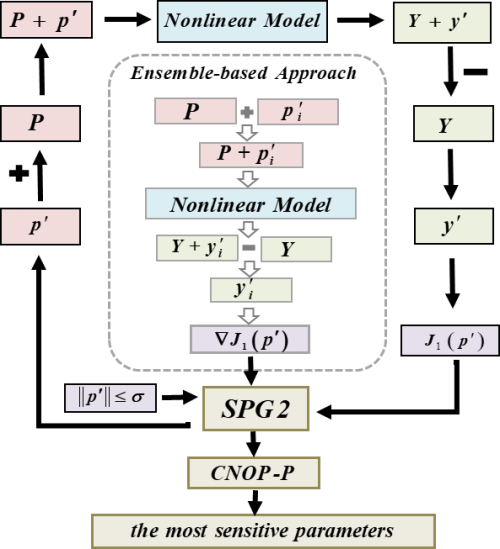Convection-allowing models (CAMs) have been receiving increasing attention in recent years owing to their potential in describing the detailed characteristics of mesoscale systems. However, the resolution is still not fine enough to resolve convective cells, as well as turbulence diffusion. This brings uncertainties to the model, which exist in association with those related to the physical parameterizations and parameters in physical schemes.
The ensemble approach has effective probabilistic forecast information, and is believed necessary for the purpose of fully exploiting the potential of CAMs. However, formulating model uncertainties for a convection-allowing ensemble prediction system (CAEPS) is a much more challenging problem, compared to well-utilized approaches in synoptic weather forecasting.
Prof. SHEN Xueshun’s group at the Numerical Prediction Center of the China Meteorological Administration and Prof. WANG Bin’s group at the Institute of Atmospheric Physics, Chinese Academy of Sciences (CAS) have collaborated to study CAEP perturbation technique for the Global/Regional Assimilation and Prediction System (GRAPES). They have had their findings published in Advances of Atmospheric Sciences.
"Model uncertainty should reasonably describe the fast nonlinear error growth of CAMs, due to the fast developing character and strong nonlinearity of convective events," says Prof. SHEN.
The team applied conditional nonlinear ensemble parameter perturbation (CNOP-P-based) in their study. By using several locally developed strong convective events that occurred in the pre-rainy season of South China, they detect the most sensitive parameters and design formulation of model uncertainty by adding stochastic perturbations into these sensitive parameters.

Flow chart for solving the CNOP-P problem by using an ensemble-based approach. (Image by WANG Lu)
The advantages of the CNOP-P-based method are examined and verified by comparing with the well-utilized stochastically perturbed physics tendencies scheme."The results indicate that the CNOP-P-based method has potential in improving the under-dispersive problem of the current CAEPS, owing to its process-specific and event-oriented formulation of model uncertainties," states Prof. SHEN.
"Much research is needed in which the CNOP-P approach is further applied in operational CAEPSs—such as, its application in heavy rainfall events in the mid-to-high latitudes, the impact of parameter perturbation constraints, the use of spatiotemporal random perturbation approaches when perturbing the parameters, and the choice of cost functions," he adds.
Citation: Wang, L., X. S. Shen, J. J. Liu, and B. Wang, 2020: Model uncertainty representation for a convection-allowing ensemble prediction system based on CNOP-P. Adv. Atmos. Sci., https://doi.org/10.1007/s00376-020-9262-z.
Media contact: Ms. LIN Zheng, jennylin@mail.iap.ac.cn
